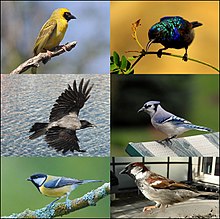
Back Sangvoëls Afrikaans Sperlingsvögel ALS የድንቢጥ ክፍለመደብ Amharic Passeriformes AN جواثم Arabic جواثم ARZ Passeriformes AST Sərçəkimilər Azerbaijani سئرچهکیمیلر AZB Турғай һымаҡтар Bashkir
| Passerine Temporal range: Eocene–Recent,
| |
|---|---|

| |
| Clockwise from top right: Palestine sunbird (Cinnyris osea), blue jay (Cyanocitta cristata), house sparrow (Passer domesticus), great tit (Parus major), hooded crow (Corvus cornix), southern masked weaver (Ploceus velatus) | |
| Song of a purple-crowned fairywren (Malurus coronatus) | |
| Scientific classification | |
| Domain: | Eukaryota |
| Kingdom: | Animalia |
| Phylum: | Chordata |
| Class: | Aves |
| Clade: | Psittacopasseres |
| Order: | Passeriformes Linnaeus, 1758 |
| Suborders | |
|
and see text | |
| Diversity | |
| Roughly 140 families, 6,500 species | |
A passerine (/ˈpæsəraɪn/) is any bird of the order Passeriformes (/ˈpæsərɪfɔːrmiːz/; from Latin passer 'sparrow' and formis '-shaped') which includes more than half of all bird species. Sometimes known as perching birds, passerines generally have an anisodactyl arrangement of their toes (three pointing forward and one back), which facilitates perching.
With more than 140 families and some 6,500 identified species,[1] Passeriformes is the largest order of birds and among the most diverse clades of terrestrial vertebrates, representing 60% of birds.[2][3] Passerines are divided into three suborders: Acanthisitti (New Zealand wrens), Tyranni (composed mostly of South American suboscines), and Passeri (oscines or songbirds).[4][5] Passerines originated in the Southern Hemisphere around 60 million years ago.[6]
Most passerines are insectivorous or omnivorous that eat both insects and fruit or seeds.
The terms "passerine" and "Passeriformes" are derived from the scientific name of the house sparrow, Passer domesticus, and ultimately from the Latin term passer, which refers to sparrows and similar small birds.
- ^ Gill, Frank; Donsker, David; Rasmussen, Pamela, eds. (2020). "Family Index". IOC World Bird List Version 10.1. International Ornithologists' Union. Retrieved 26 April 2020.
- ^ Ericson, P.G.P. et al. (2003) Evolution, biogeography, and patterns of diversification in passerine birds. J. Avian Biol, 34:3–15.
- ^ Selvatti, A.P. et al. (2015) "A Paleogene origin for crown passerines and the diversification of the Oscines in the New World". Molecular Phylogenetics and Evolution, 88:1–15.
- ^ Barker, F. Keith; Barrowclough, George F.; Groth, Jeff G. (2002). "A phylogenetic hypothesis for passerine birds: Taxonomic and biogeographic implications of an analysis of nuclear DNA sequence data". Proceedings of the Royal Society B: Biological Sciences. 269 (1488): 295–308. doi:10.1098/rspb.2001.1883. PMC 1690884. PMID 11839199.
- ^ Cite error: The named reference
ericson2002was invoked but never defined (see the help page). - ^ Claramunt, S.; Cracraft, J. (2015). "A new time tree reveals Earth history's imprint on the evolution of modern birds". Science Advances. 1 (11): e1501005. Bibcode:2015SciA....1E1005C. doi:10.1126/sciadv.1501005. PMC 4730849. PMID 26824065.
© MMXXIII Rich X Search. We shall prevail. All rights reserved. Rich X Search